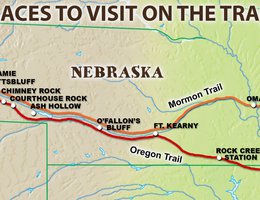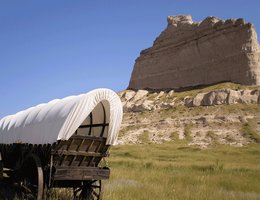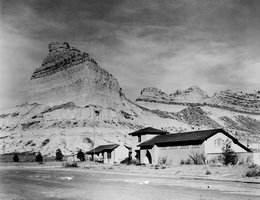

Chimney Rock was one of the best-known landmarks on the Oregon and Mormon Trails. About 350,000 pioneers passed by Chimney Rock. Fur trader Warren A. Ferris left the oldest known written description of Chimney Rock. On May 26, 1830, his party reached " ‘Nose Mountain,’ or as it is more commonly called, the ‘Chimney,’ a singular mound, which has the form of an inverted funnel." Joseph Hackney, a "Forty-Niner" on his way to the California gold fields, described Chimney Rock as "the most remarkable object" he had ever seen. Many nineteenth century travelers stopped to wonder at this "natural curiosity."
Hundreds of later travelers also described this impressive landmark. Chimney Rock was the first of many spectacular sights along the Oregon-California Trail. Its reputation grew, no doubt because it came early in the journey and after many miles of flat plains.

Many travelers carved their names on Chimney Rock, though few carvings lasted long.
"I engraved my name and the name of my wife. There were several Ladies and Gentlemen on the rock with me; and after I had completed my name I looked to my left and there stood a young lady who had cut foot and handholes in the soft rock busily engaged in scribing her name about 2 feet higher than my own."
— James W. Evans, 1850.
The natural forces of deposition and erosion, slow forces that shape the earth, formed Chimney Rock. Many observers, like Israel F. Hale in 1849, predicted that the rock would fall.
"Even the names that were written yesterday [in the rock at the base] were nearly obliterated by the storm last night ... If I mistake not, the famous Chimney Rock before many years will be among the things that were known in history ... I am very sure it cannot stand many years before large flakes will slide to the ground, if all does not come down in a general crash."

Wind and water also shaped the formations, Jailhouse and Courthouse Rocks, that the travelers first experienced east of Chimney Rock and Scott’s Bluff, further west along the North Platte Valley. You can image the surprise of the Oregon Trail travelers when they came upon a high bluff in the middle of the Great Plains. Scott’s Bluff was name for Hiram Scott, a fur trapper, who died there in 1823. He was injured or became ill near the bluff, and when he was unable to travel, his partners abandoned him.
Scott’s Bluff is a range of high, rugged, broken hills along the banks of the North Platte River. Oregon Trail travelers had to make a long detour around the south side of the bluff. By 1851 a road was made through a gap in the bluff called Mitchell Pass. Today a road leads from the Oregon Trail Museum and Visitor Center to the top of the bluff.

Hundreds of thousands of Americans were struck with "the fever" when gold was discovered at Sutter’s Mill in California in 1848. The gold discovery caused another huge wave of migration west. While some Americans chose to sail to California on the famous Clipper Ships, most gold seekers journeyed overland from the Missouri River feeder towns such as Independence, St. Joseph, and Kanesville (present-day Council Bluffs). Through Nebraska, most travelers followed the established Oregon Trail, which became known as the California or "Forty-Niner’s" Trail.
Despite hardships, it is estimated that over 40,000 gold-seekers migrated to California in 1849 and over 65,000 in 1850. One emigrant wrote in 1850:
"I had intended to notice in my journal every grave and burying place that we passed, but I have abandoned this part of my plan ... Graves are so numerous, that to notice them all would make my narrative tedious."
The trip to California was long and difficult, with disease, heat, lack of water, and the threat of Indian attacks the constant dangers. But the call to adventure, possible riches, and a new start in life encouraged the hardy pioneers in make the journey.